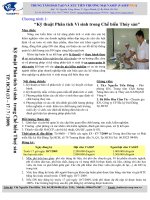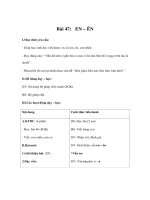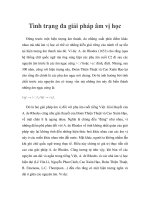Sinh-Hk2-Đc-Tham-Khảo.vi.en.docx
Bạn đang xem bản rút gọn của tài liệu. Xem và tải ngay bản đầy đủ của tài liệu tại đây (193.76 KB, 8 trang )
Translated from Vietnamese to English - www.onlinedoctranslator.com
REVIEW EXERCISE 11
Question 1: Choose true / false?
Stated
Correc Wro
t
ng
first-Development in plants is the sum total of changes that take place in the life cycle of
an individual, expressed through three unrelated processes: growth, differentiation and
morphogenesis that make up the organs of the organism.
X
2-Photoperiod is the correlation of day and night lengths in a season
X
3- Dragon fruit and sunflower are long-day plants
X
4-In flowering plants, the embryo sac formation process undergoes 1 meiosis, 3 times of X
mitosis
5-The development process of animals that give birth includes the embryonic and
postnatal stages
6-In flowering plants, the male gametophyte is formed from anther cells that mitosis twice
for 4 microspores → 1 cell from mitosis once for 1 pollen grain containing 1 reproductive
cell and 1 pollen tube cell → reproductive cell mitosis once to produce 2 male gametes
X
X
Verse 2.For the following plant species: barley, coffee, wheat, tea, rice, sunflower
Classify plants by photoperiod?
Long day crops: barley, wheat
Short day plants: coffee, tea, rice
Neutral plant: sunflower---------------------------------------------------------------------------------------------------------------------------------------------------------------------------------------------------------------------------------------------------------------------------------------------------------------------------------------------------------------------------------------------------------------------------------------------------------------------------------------------------------------------------------------------------------------------------------------------------------------------------------------------------------------------------------------------------------------------------------------------------------------------------------------------------------------------------------------------------------Verse 3.Tomato plants flower when reaching the 14th leaf………………..
Verse 4.Testosterone is produced in ……testicles………….
Question 5.If the pituitary gland produces too little or too much growth hormone in childhood, it results in
……………………
Verse 6.The important factor that determines the growth and development of animals is…………Genetic
factor……………..
Verse 7.Estrogen is produced in ……ovaries…………………….
Verse 8.Growth hormone (GH) is produced in ……anterior pituitary …………………….
Verse 9.Thyroxine is produced in …………thyroid glands…………..
Verse 10.Consequences for children with a lack of thyroxine are growth retardation, stunted
growth……………………..or ……poor intelligence…………………….
Verse 11.Stomach reproduction is the production of a new generation from…………
spores………….formed from a sac…spore………….
Verse 12.In vegetative reproduction in plants, a new plant is created………..vegetative parts of the plant
(leaves, roots, stems)……………………..
Verse 12.Asexual reproduction is a form of reproduction……without the fusion of male and female
gametes, the offspring is the same and the mother plant………………. ………….
Verse 13.Growth of an animal's body is the process of increasing the size of the body
A. Organ systems in the body
B. cbody due to an increase in the size and number of cells
C. tissues in the body
D. cevil organs in the body
Verse 14.For the following species:
Carp; Chicken; Rabbit; Mosquito Orange wings; Monkey; Mantis
OLDo Rao; Ladybug;
Flies
Based on the growth pattern of the species, classify the species above?
Development without metamorphosis: Monkey, rabbit, chicken, carp
Development through complete metamorphosis: flies, mosquitoes, orange wings, ladybugs
Development through incomplete metamorphosis: locusts, mantises, shrimps, crabs----------------------------------------------------------------------------------------------------------------------------------------------------------------------------------------------------------------------------------------------------------------------------------------------------------------------------------------------------------------------------------------------------------------------------------------------------------------------------------------------------------------------------------------------------------------------------------------------------------------------------------------------------------------------------------------------------------------------------------------------------------------------------------Verse 15.Name the hormones that mainly affect growth and development in vertebrates?
Growth hormone, thyroxin, estrogen, testosterone--------------------------------------------------------------------------------------------------------------------------------------------------------------------------------------------------------------------------------------------------------------------------------------------------------------------------------------------------------------------------------------------------------------------------------------------Verse 16.Metamorphosis is change
A. sudden morphological, structural and physiological decline in animals after birth or hatching from eggs
B. gradual morphological, structural and physiological abruptness of animals after birth or hatching from
eggs
C. sudden changes in the morphology, structure and physiology of animals after birth or hatching
from eggs
D. slowly on the morphology, structure and physiology of animals after birth or hatching from eggs
Verse 17.The growth and development of animals through metamorphosis is not the case when larvae
develop
A. complete, through many transformations the larva turns into an adult
B. incomplete, through many transformations the larva turns into an adult
C. incomplete, through one molt the larva turns into an adult
D. incomplete, through many molting larvae turn into adults
Verse 18.The type of development of animals through complete metamorphosis is the type of
development that is still young with morphological characteristics
A. The structure and physiology are very different from that of an adult
B. similar in structure to adults, but different physiologically
C. similar in structure and physiology to adults
D. structure and physiology are similar to adults
Verse 19.The development of an animal's body consists of closely related processes that are
A. growth and morphogenesis of organs and bodies
B. cell growth and differentiation
C. growth, cell differentiation and morphogenesis of organs and bodies
D. cell differentiation and morphogenesis of organs and bodies
Verse 20.In oviparous animals, the growth and development of the embryonic stage is ordered
A. zygote → tissues and organs → embryo
B. PHoh → zygote → tissues and organs
C. Embryo → tissues and organs → zygote
D. FAMILYzygote → embryo → tissues and organs
Verse 21.Estrogen has a role
A. Stimulates growth and development of secondary sexual characteristics in males
B. enhances protein biosynthesis, thereby stimulating cell division and increasing cell size, thereby
increasing body growth
C. stimulates growth and development of secondary sexual characteristics in offspring
D. stimulates metabolism in cells, stimulates the growth and normal development of the body
Verse 22.Thyroxin has a stimulant effect
A. Protein biosynthesis, thereby stimulating cell division and increasing cell size, thus enhancing the
growth of the organism.
B. metabolizing in cells, stimulating the body's normal growth and development
C. growth and development of secondary sexual characteristics in males
D. growth and development of secondary sexual characteristics in offspring
Verse 23.Growth hormone plays a role
A. Enhance protein biosynthesis, thus Stimulate cell division and increase cell size, thus enhancing
body growth
B. stimulates metabolism in cells and normal growth and development of the body
C. stimulates growth and development of secondary sexual characteristics in males
D. stimulates growth and development of secondary sexual characteristics in offspring
Verse 24.Testosterone has a stimulating role
A. growth and development of secondary sexual characteristics in males
B. metabolism in cells and normal growth and development of the body
C. the process of protein biosynthesis, thereby stimulating cell division and increasing cell size, thus
enhancing the growth of the body.
D. growth and development of secondary sexual characteristics in offspring
Verse 25.Edison causes
A. inhibits the molting of caterpillars, stimulates the caterpillars to turn into pupae and butterflies
B. inhibiting the molting of caterpillars, inhibiting caterpillars turning into pupae and butterflies
C. molting of caterpillars, which stimulates the caterpillars to turn into pupae and butterflies
D. moulting of caterpillars, inhibiting caterpillars turning into pupae and butterflies
Verse 26.Juvenin causes
A. moulting of caterpillars, stimulating the caterpillars to turn into pupae and butterflies
B. inhibiting worms from turning into pupae and butterflies
C. inhibits the molting of caterpillars, stimulates the caterpillars to turn into pupae and butterflies
D. inhibits molting of caterpillars, inhibits squirrels from turning into pupae and butterflies
Verse 27.For the following hormones:
first-Testosterone
2-Estrogen
3-Edison
4-Juvenin
5-GH
6-FSH
The type of hormone that mainly affects the growth and development of foreign insects
A. (3) B. (3) and (4)
C. (1), (2) va (4) D. (3), (4), (5) and (6)
Verse 28.During human development, environmental factors have the greatest effect on
A. embryo
B. somg
C. after somg
D. childrengrow up
Verse 29.When it is cold, heat-reducing animals mature and develop slowly because the decrease in body
temperature causes metabolism in the body
A. reduction leads to limited energy consumption
B. Stronger generates more energy to fight
the cold
C. decreased, reproduction increased
DTeat, fertility decreases
Verse 30.Sunbathing in the early morning or evening (low light) is beneficial for the growth and
development of young children because ultraviolet rays make provitamin D turn into vitamin D.
A. Metabolizes Na to form bones
B. Metabolize Ca for Bone Formation
C. metabolises K to form bone
D. oxidationa to form bones
Verse 31.When the cold season arrives, the growth and development of endothermic animals is affected
because the decrease in body temperature causes the metabolism to decrease.
A. and reduced fertility
B. Increases energy in the body to fight cold
C. in the body decreases leading to limited energy consumption
D. in the body decreased, reproduction decreased
Verse 32.Consider the following botanical branches:
first-Conifers 2-Moss
3-Decided
4-Angiosperm seeds
Reproduction by stomach is found in
A. (1) and (2) B. (1) and (4)
C. (2) and (3)D. (3) and (4)
Verse 33.Asexual reproduction in plants is when young plants are born with the characteristics of
A. Like the parent plant, there is a fusion of male and female gametes
B. same as the parent plant, without the fusion of male and female gametes
C. like the parents, there is the fusion of male and female gametes
D. the same and different from the parent plant, without the fusion of male and female gametes
Verse 34.Consider the following features:
first-Single, independent living individuals can still produce offspring. So beneficial in case of low
population density
2-Create individuals that are well-adapted to a stable and less volatile living environment, so that the
population grows quickly
3-Produces new individuals that are similar and similar to the mother in terms of heredity
4-Generate a number of seed offspring in a short time
5-Allows increased reproductive efficiency because energy is not expended for gamete generation and
fertilization
6-Creating genetically similar progeny should have an advantage when living conditions change
What are the characteristics of asexual reproduction?
A. (1), (2), (3), (4) and (6) B. (3) and (5)
C. (1) va (2) D. (1), (2), (3), (4) and (5)
Verse 35.In nature, bamboo can reproduce by
A. accessory roots B. internodes
C. bodyn roots D. bovine stem
Verse 36.Spores in plants carry a set of chromosomes (chromosomes)
A. diploid and haploid plant formation
B. haploid and diploid plant formation
C. haploid and haploid plant formation
D. ldiploid and diploid plant formation
Verse 37.The characteristic of spores is to produce
A. many individuals of a single generation, dispersed solely by water, ensuring an extensive range of the
species' distribution
B. few individuals of a generation, dispersed by wind and water, ensuring the expansion of the species'
distribution area
C. few individuals of a generation, dispersed only by the wind, ensuring an extensive distribution of the
species
D. many individuals of a generation, dispersed by wind and water, ensuring the expansion of the
species' distribution area
Verse 38.To propagate perennial fruit trees, people often cut branches because
A. Seedlings are easy to grow and take care of
B. This method helps to propagate quickly and much
C. this method helps to avoid harmful pests
D. This method helps to shorten the growth time of the tree, early harvest and know the
characteristics of the fruit in advance
Verse 39.Characteristics that are not part of asexual reproduction are
A. The baby's body is completely identical to the original mother's body
B. produces new individuals that are very diverse in adaptive characteristics
C. produce a large number of descendants in a short time
D. produces individuals that are well-adapted to a stable habitat
Verse 40.The reproductive form of the fern is reproduction
A. by sporesB. dichotomous C. nutritionnourishing D. sexual
Verse 41.What is the advantage of sexual reproduction over asexual reproduction in plants?
a- the ability to adapt to changing environmental conditions
b-create many variations as raw materials for the process of breeding and evolution
c- stable maintenance of genetically good traits
d-common form of reproduction
How many correct answers are there?
A. 1
B. 2
C. 3
D. 0
Verse 42.Sexual reproduction in plants is a combination
A. selection of two male and female gametes creates a zygote that develops into a new organism
B. randomly two male and female gametes form a zygote that develops into a new organism
C. selection of female gametes and multiple gametes are produced to form a zygote that develops into a
new organism
D. of many male gametes with one female gamete forming a zygote that develops into a new plant
Verse 43.Fertilization in flowering plants is a combination
A. two haploid sets of male and female gametes (eggs) in the embryo sac form a diploid zygote
B. the nucleus of 2 male and female gametes (eggs) in the embryo sac forms a zygote
C. nucleus of male gamete with nucleus of egg and polar nucleus in blastocyst form zygote and endosperm
nucleus
D. of two spermatozoa with an egg in the blastocyst
Verse 44.Self-pollination is the
A. Pollination of the pollen grains of one plant with the stigmas of other plants of the same species
B. pollination of pollen grains with pistils of the same flower or different flowers of the same plant
C. Pollination of pollen grains of this plant with plants of other species
D. union of the sperm of one plant with the eggs of another plant
Verse 45.What is not true about fruit is
A. the fruit that is grown by the thick ovary is transformed into
B. seedless fruits are all too monoecious
C. the fruit has the role of protecting the seed
D. fruit can be a means of seed dispersal
Verse 46.Double fertilization in flowering plants is a combination of
A. multiply 2 male and female gametes (eggs) in the embryo sac to form a zygote
B. two male gametophytes with egg nucleus and polar nucleus in blastocyst form zygote and
endosperm nucleus
C. two haploid sets of male and female gametes (eggs) in the embryo sac form a zygote with diploid
chromosomes
D. two spermatozoa with an egg in the embryo sac
Verse 47.Cross pollination is the pollination between
A. pollen of this plant with the stigma of a different species
B. pollen grains with pistils of the same flower or different flowers of the same plant
C. pollen of one plant with the stigma of another plant of the same species
D. pollen and eggs of the same flower
Verse 48.How many things are not true about seeds?
A. A seed is a fertilized ovum that develops into
B. the zygote in the seed develops into an embryo
C. triploid cells in seeds develop into endosperm
D. every seed of a flowering plant has an endosperm
A. 1
B. 2
C. 4
D. 3
Verse 49.During fertilization of flowering plants, the chromosome set of the nucleus, including the nucleus
of the gametophyte, is n,
A. of polar nucleus is 2n, of egg is n, of zygote is 2n, of endosperm is 2n
B. of polar nucleus is 2n, of egg is n, of zygote is 2n, of endosperm is 4n
C. of polar nucleus is n, of egg is n, of zygote is 2n, of endosperm is 3n
D. of polar nucleus is 2n, of egg is n, of zygote is 2n, of endosperm is 3n
Verse 50.Which of the following statements is correct about double fertilization?
first-Double fertilization is a phenomenon in which both nuclei participate in fertilization, one nucleus
fuses with the egg, the other fuses with the diploid nucleus (2n) to form a triploid cell (3n).
2-Double fertilization occurs only in flowering plants
3-Double fertilization occurs only in angiosperms
4-Double fertilization ensures that the right nutrients are stored in the fertilized ovum to nourish the
developing embryo until the formation of autotrophic young plants, ensuring the ability to adapt to the
changing conditions of the environment. to maintain the breed
5-All plants that reproduce sexually have double fertilization
The correct answer option is:
A. 2 B. 3 C. 4 D. 5
Question 51: Observe the picture
Based on the picture above, describe the formation of pollen grains and embryo sacs?
--------------------------------------------------------------------------------------------------------------------------------------------------------------------------------------------------------------------------------------------------------------------------------------------------------------------------------------------------------------------------------------------------------------------------------------------------------------------------------------------------------------------------------------------------------------------------------------------------------------------------------------------------------------------------------------------------------------------------------------------------------------------------------------------------------------------------------------------------------------------------------------Question 52: Based on the picture, the place of production and the role of hormones Ecdixxon and Juvenin?
The anterior thoracic gland produces ecdixons, which have the role of:
+ cause makeover
+ stimulates worms -> pupae -> butterflies-----------------------------------------------------------------------The allata body produces juvenin, juvenin has the role of:
+ coordinate with ecdixon to perform the molting process
+ suppress the transformation from worm -> pupa -> butterfly----------------------------------------------------------------------------------------------------------------------------------------------------------------------------------------------------------------------------------------------------------------------------------------------------------------------------------------------------------------------------------------------------------------------------------------------------------------------------------------------------------------------------------------------------------------------------------------------------------------------------------------------------------------------------------









